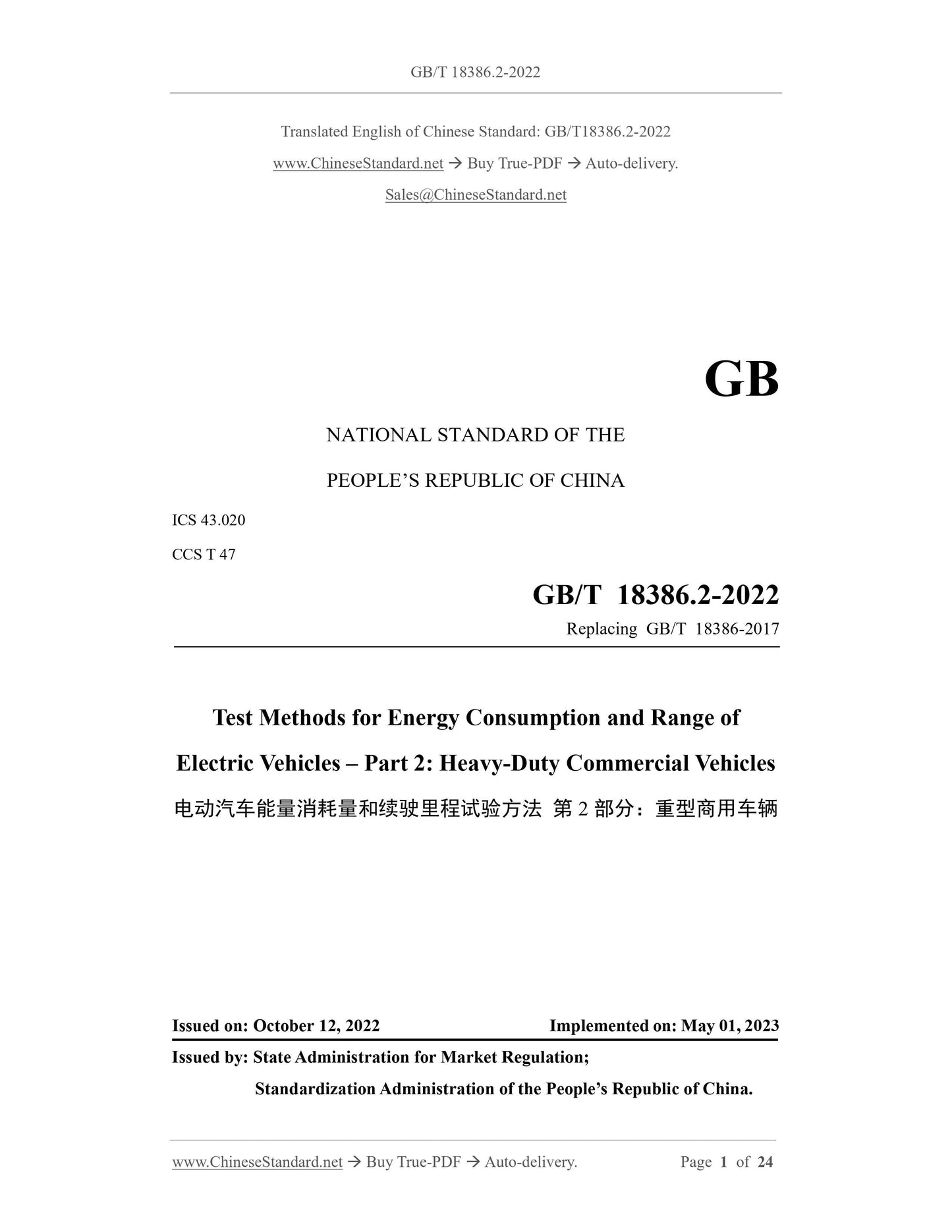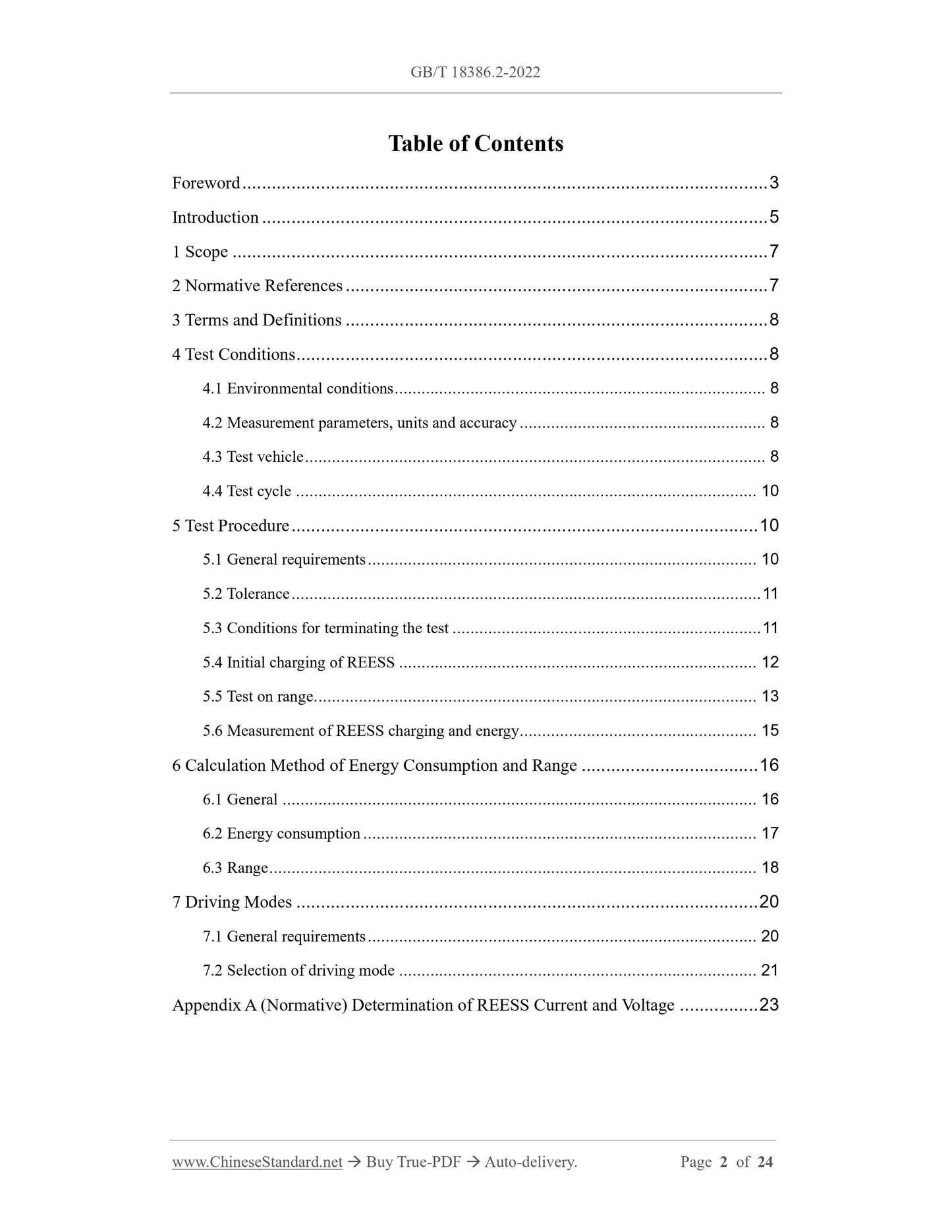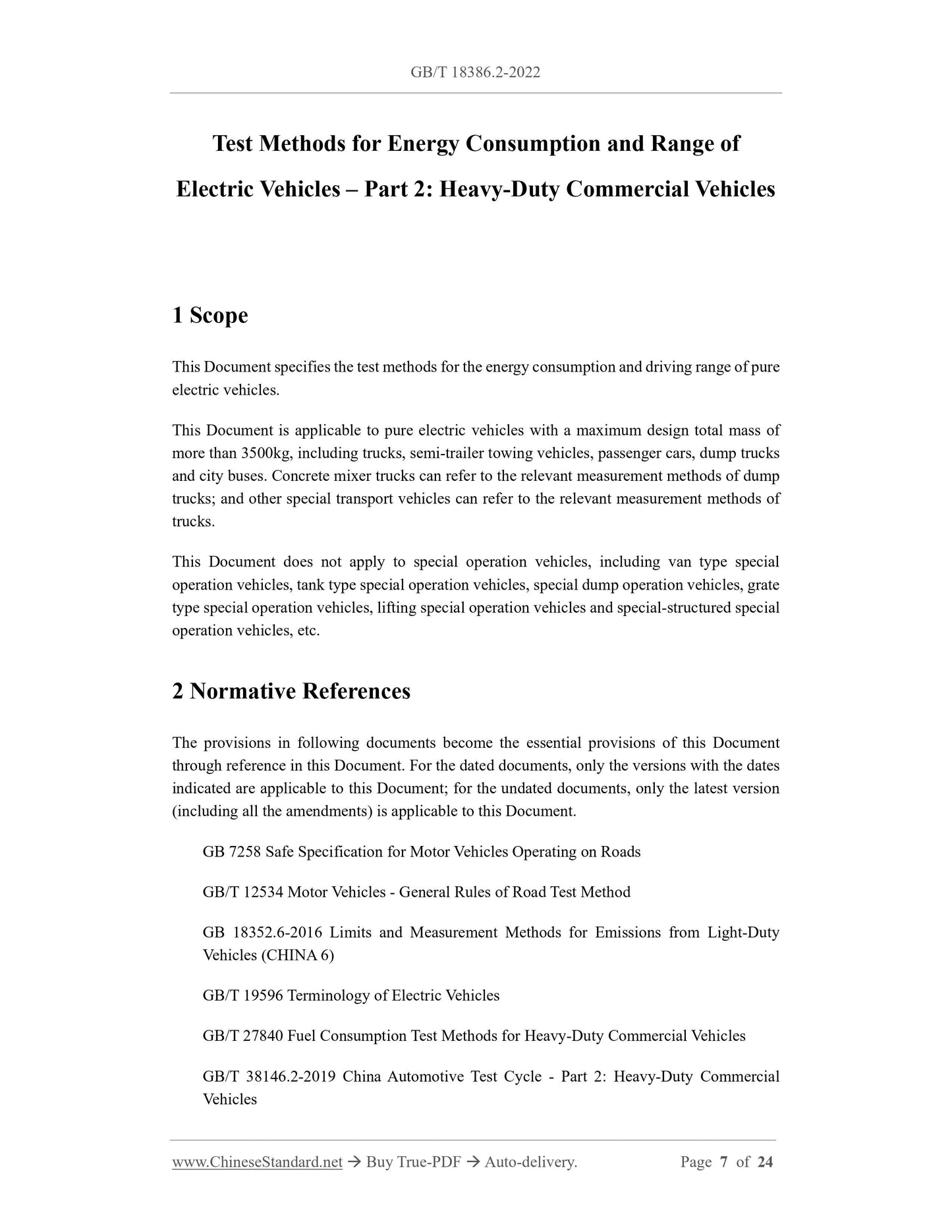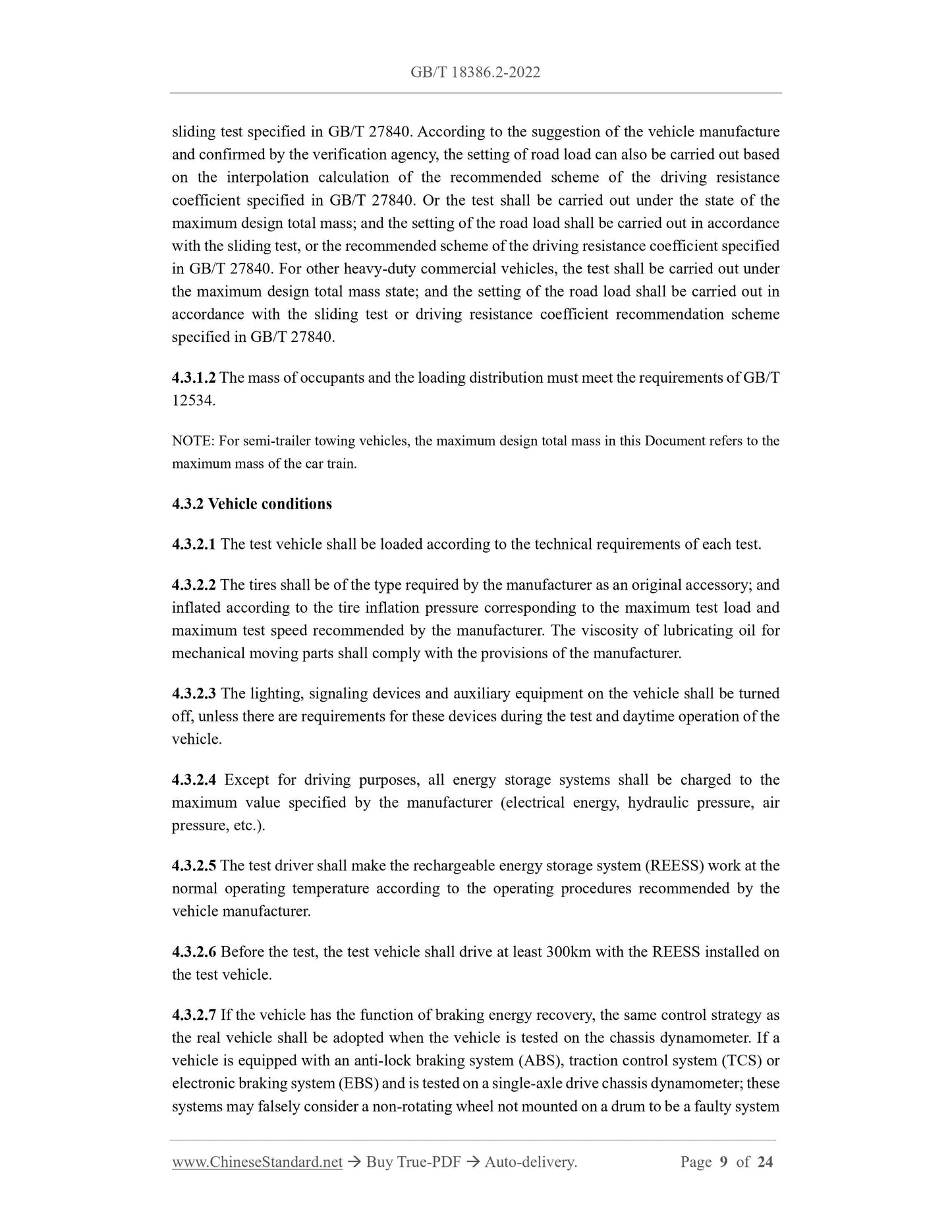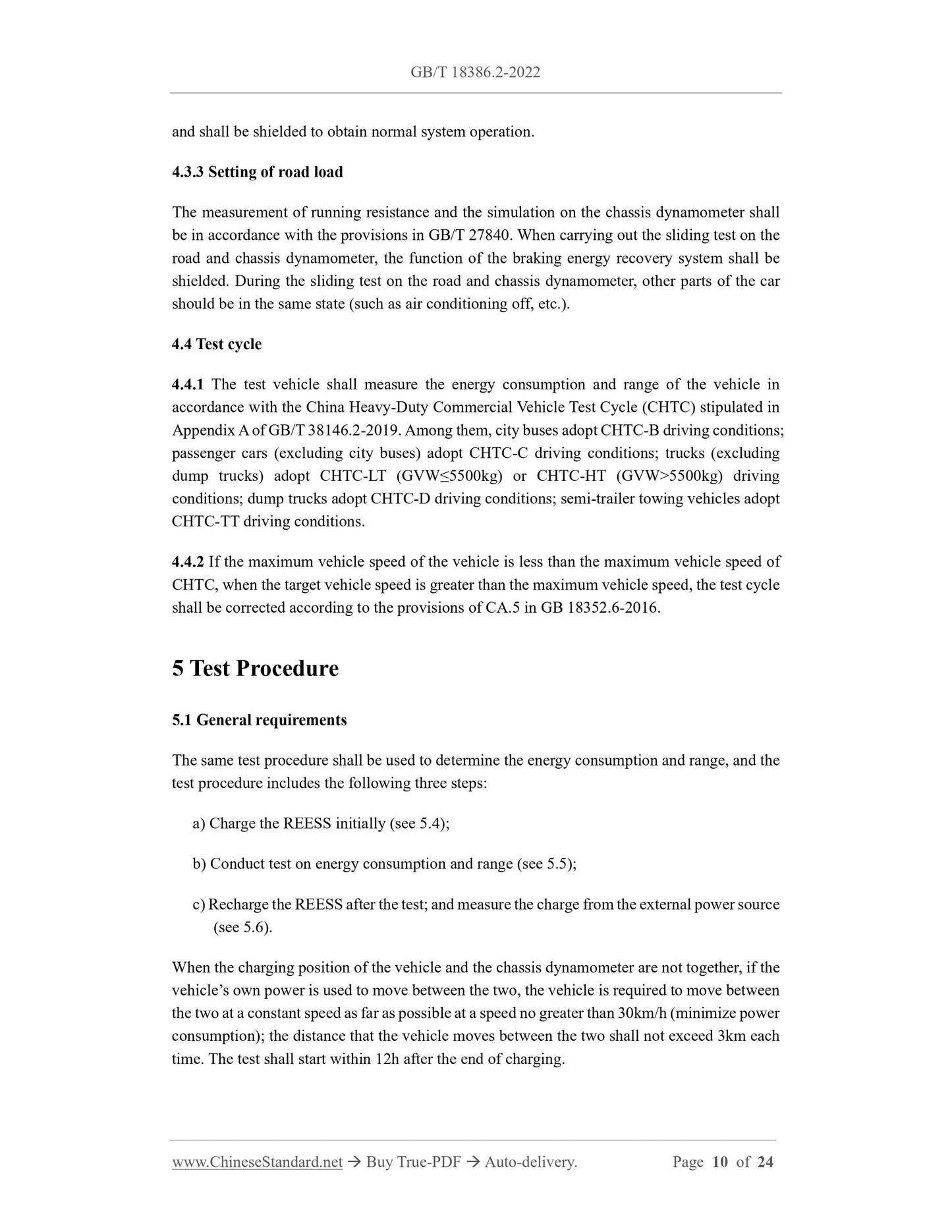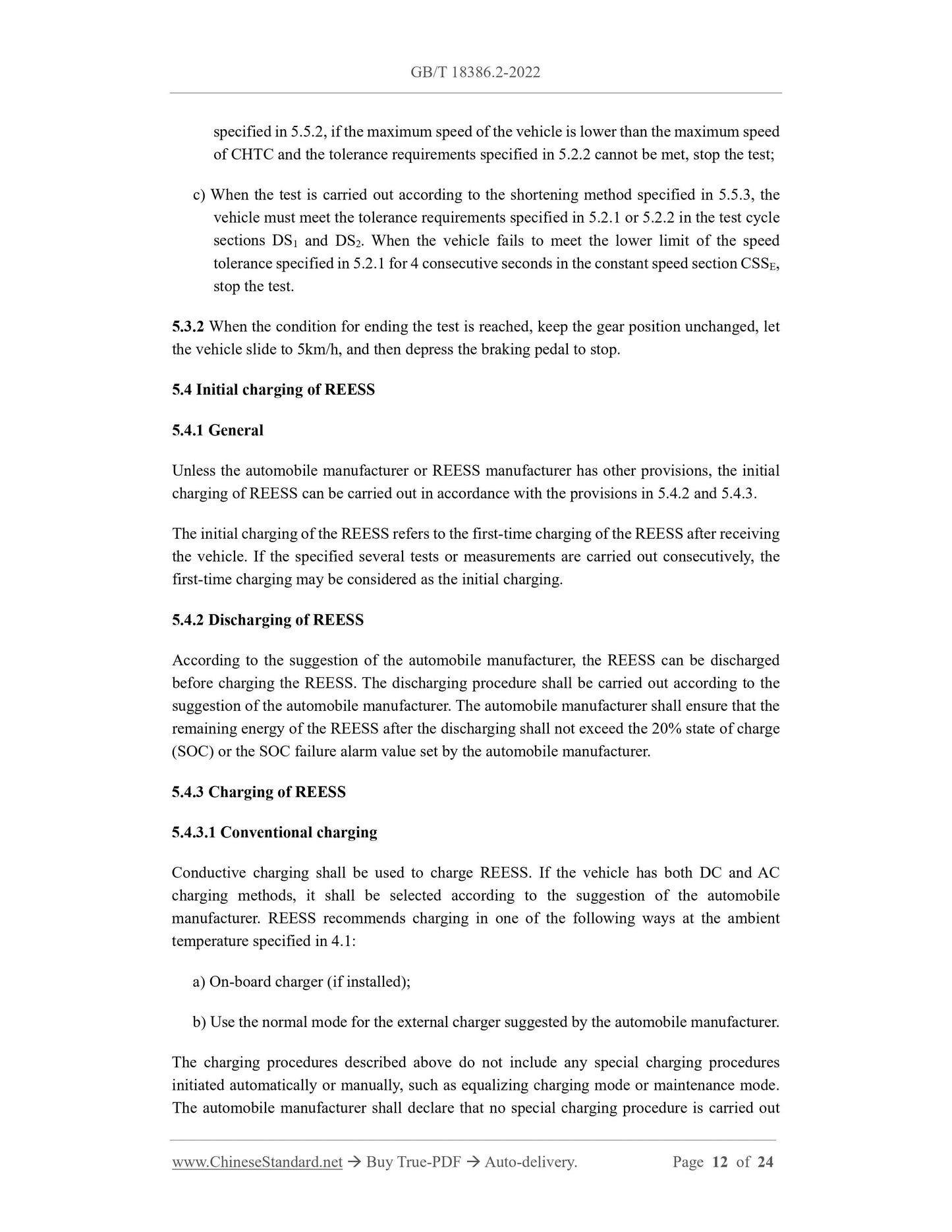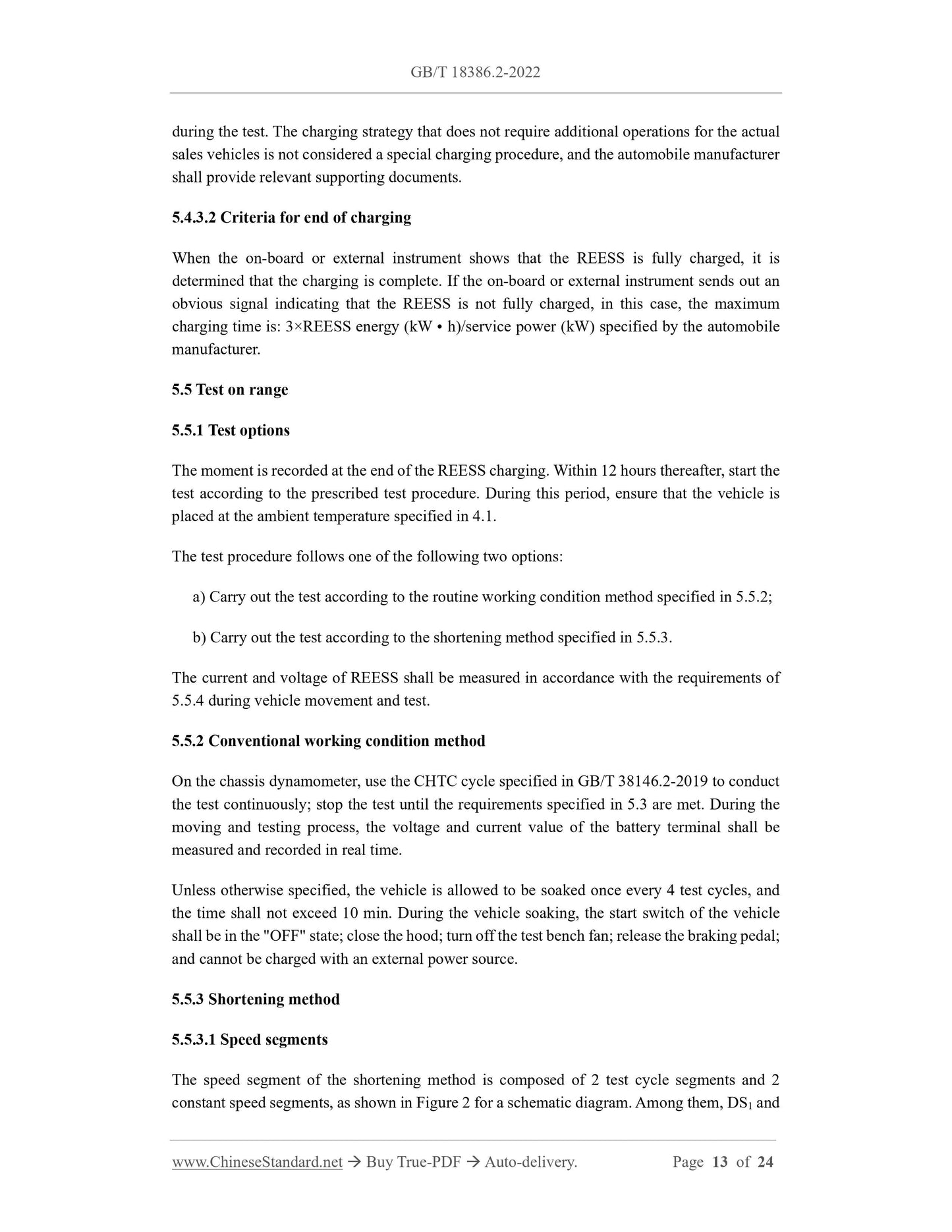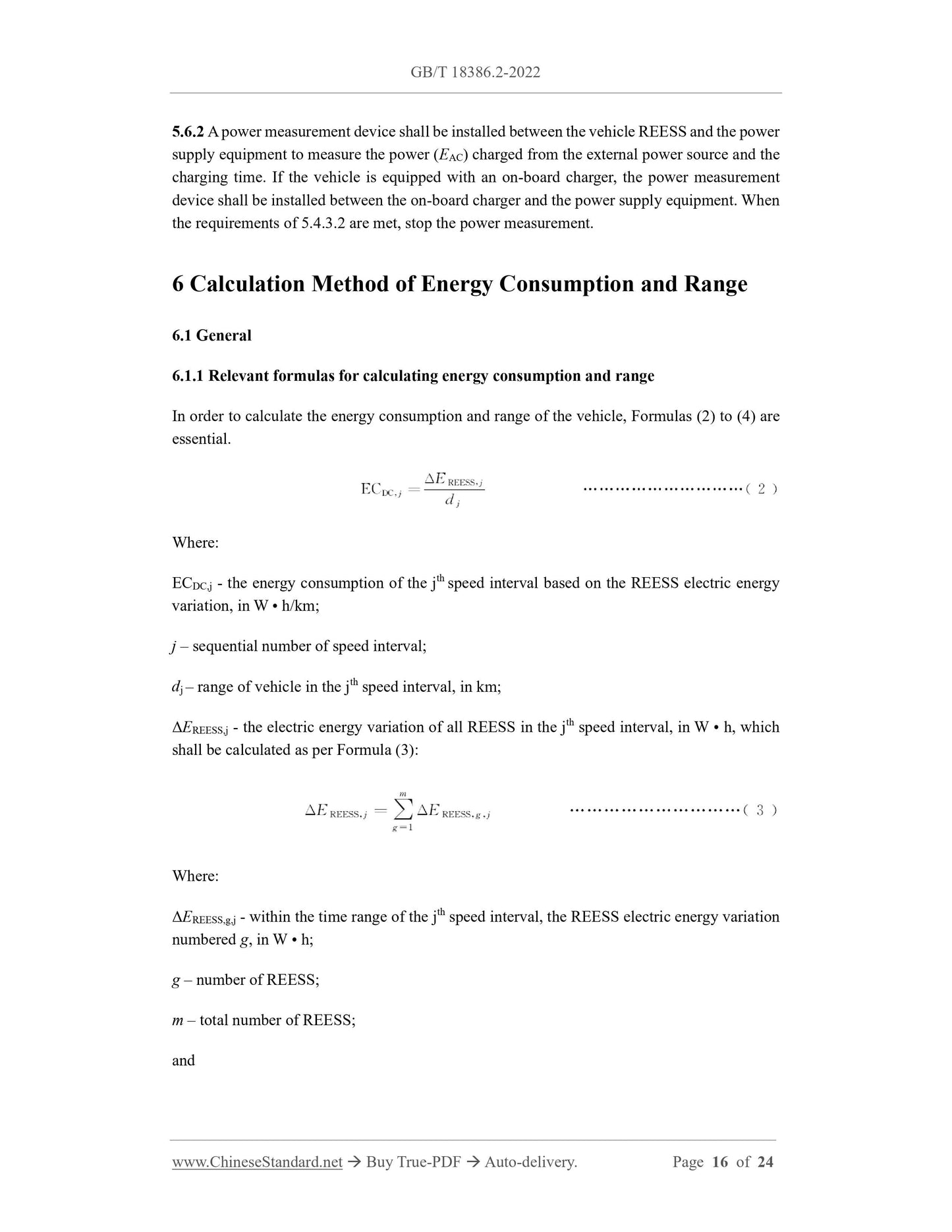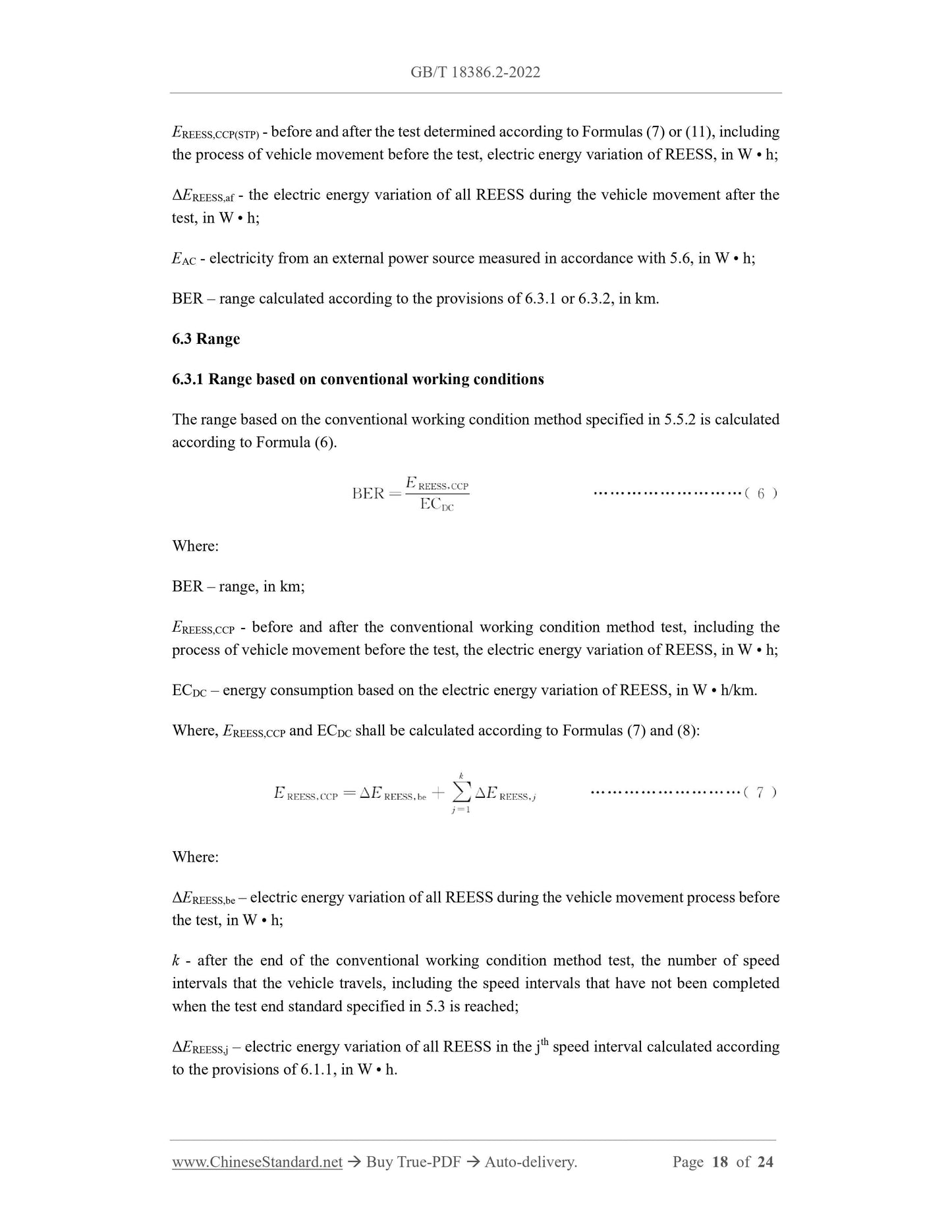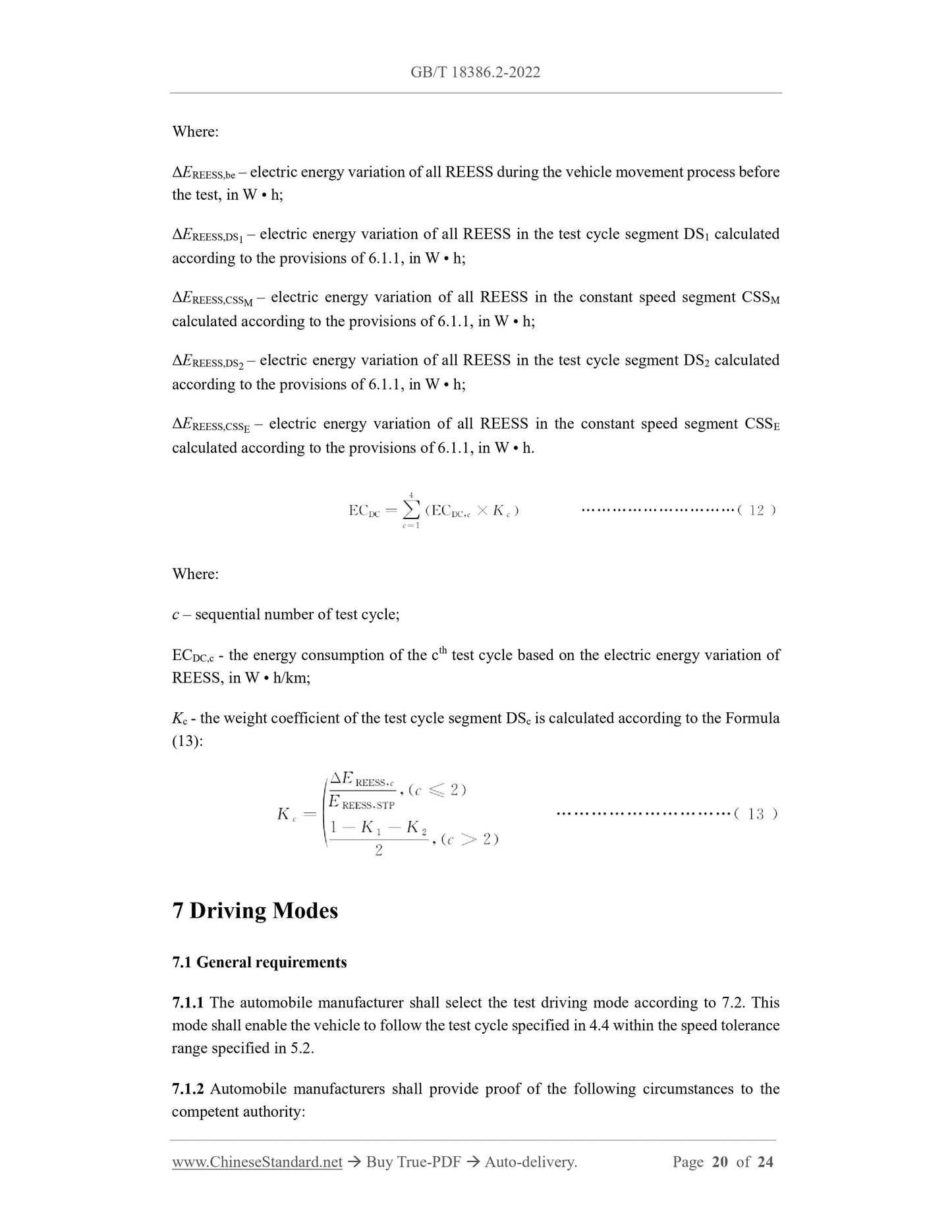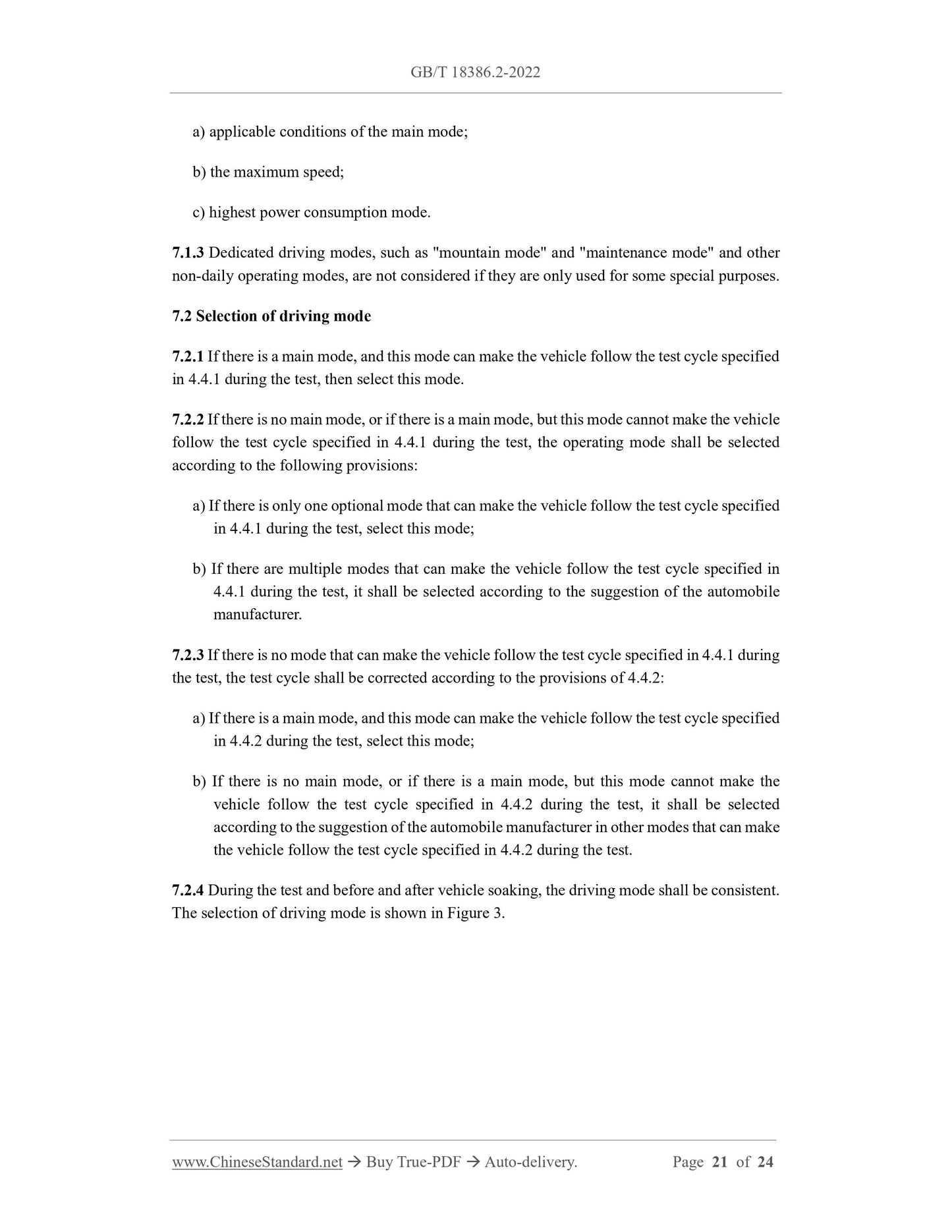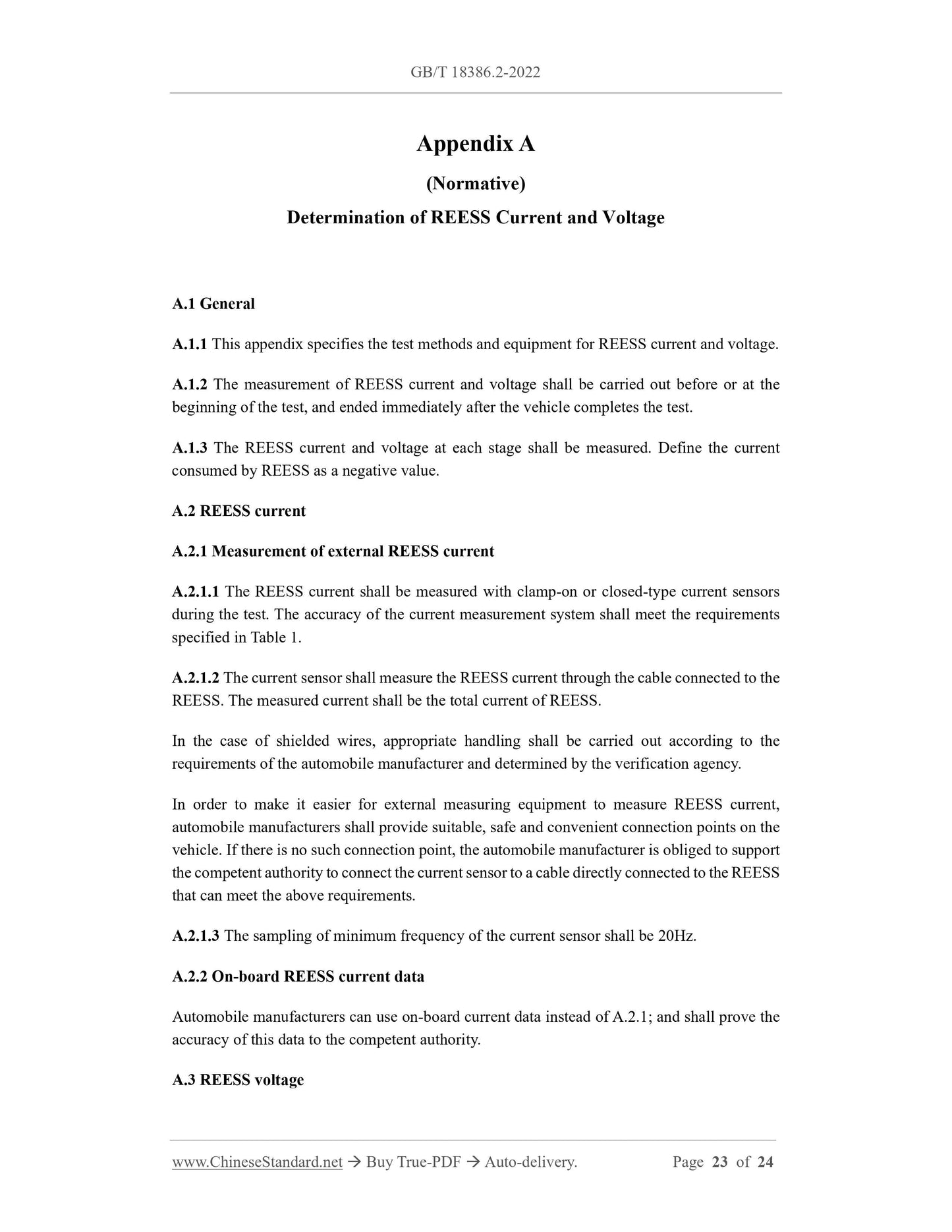1
/
of
12
PayPal, credit cards. Download editable-PDF and invoice in 1 second!
GB/T 18386.2-2022 English PDF (GBT18386.2-2022)
GB/T 18386.2-2022 English PDF (GBT18386.2-2022)
Regular price
$185.00 USD
Regular price
Sale price
$185.00 USD
Unit price
/
per
Shipping calculated at checkout.
Couldn't load pickup availability
Delivery: 3 seconds. Download true-PDF + Invoice.
Get QUOTATION in 1-minute: Click GB/T 18386.2-2022
Historical versions: GB/T 18386.2-2022
Preview True-PDF (Reload/Scroll if blank)
GB/T 18386.2-2022: Test methods for energy consumption and range of electric vehicles -- Part 2: Heavy-duty commercial vehicles
GB/T 18386.2-2022
GB
NATIONAL STANDARD OF THE
PEOPLE’S REPUBLIC OF CHINA
ICS 43.020
CCS T 47
Replacing GB/T 18386-2017
Test Methods for Energy Consumption and Range of
Electric Vehicles – Part 2: Heavy-Duty Commercial Vehicles
ISSUED ON: OCTOBER 12, 2022
IMPLEMENTED ON: MAY 01, 2023
Issued by: State Administration for Market Regulation;
Standardization Administration of the People’s Republic of China.
Table of Contents
Foreword ... 3
Introduction ... 5
1 Scope ... 7
2 Normative References ... 7
3 Terms and Definitions ... 8
4 Test Conditions ... 8
4.1 Environmental conditions ... 8
4.2 Measurement parameters, units and accuracy ... 8
4.3 Test vehicle ... 8
4.4 Test cycle ... 10
5 Test Procedure ... 10
5.1 General requirements ... 10
5.2 Tolerance ... 11
5.3 Conditions for terminating the test ... 11
5.4 Initial charging of REESS ... 12
5.5 Test on range ... 13
5.6 Measurement of REESS charging and energy ... 15
6 Calculation Method of Energy Consumption and Range ... 16
6.1 General ... 16
6.2 Energy consumption ... 17
6.3 Range ... 18
7 Driving Modes ... 20
7.1 General requirements ... 20
7.2 Selection of driving mode ... 21
Appendix A (Normative) Determination of REESS Current and Voltage ... 23
Test Methods for Energy Consumption and Range of
Electric Vehicles – Part 2: Heavy-Duty Commercial Vehicles
1 Scope
This Document specifies the test methods for the energy consumption and driving range of pure
electric vehicles.
This Document is applicable to pure electric vehicles with a maximum design total mass of
more than 3500kg, including trucks, semi-trailer towing vehicles, passenger cars, dump trucks
and city buses. Concrete mixer trucks can refer to the relevant measurement methods of dump
trucks; and other special transport vehicles can refer to the relevant measurement methods of
trucks.
This Document does not apply to special operation vehicles, including van type special
operation vehicles, tank type special operation vehicles, special dump operation vehicles, grate
type special operation vehicles, lifting special operation vehicles and special-structured special
operation vehicles, etc.
2 Normative References
The provisions in following documents become the essential provisions of this Document
through reference in this Document. For the dated documents, only the versions with the dates
indicated are applicable to this Document; for the undated documents, only the latest version
(including all the amendments) is applicable to this Document.
GB 7258 Safe Specification for Motor Vehicles Operating on Roads
GB/T 12534 Motor Vehicles - General Rules of Road Test Method
GB 18352.6-2016 Limits and Measurement Methods for Emissions from Light-Duty
Vehicles (CHINA 6)
GB/T 19596 Terminology of Electric Vehicles
GB/T 27840 Fuel Consumption Test Methods for Heavy-Duty Commercial Vehicles
GB/T 38146.2-2019 China Automotive Test Cycle - Part 2: Heavy-Duty Commercial
Vehicles
sliding test specified in GB/T 27840. According to the suggestion of the vehicle manufacture
and confirmed by the verification agency, the setting of road load can also be carried out based
on the interpolation calculation of the recommended scheme of the driving resistance
coefficient specified in GB/T 27840. Or the test shall be carried out under the state of the
maximum design total mass; and the setting of the road load shall be carried out in accordance
with the sliding test, or the recommended scheme of the driving resistance coefficient specified
in GB/T 27840. For other heavy-duty commercial vehicles, the test shall be carried out under
the maximum design total mass state; and the setting of the road load shall be carried out in
accordance with the sliding test or driving resistance coefficient recommendation scheme
specified in GB/T 27840.
4.3.1.2 The mass of occupants and the loading distribution must meet the requirements of GB/T
12534.
NOTE: For semi-trailer towing vehicles, the maximum design total mass in this Document refers to the
maximum mass of the car train.
4.3.2 Vehicle conditions
4.3.2.1 The test vehicle shall be loaded according to the technical requirements of each test.
4.3.2.2 The tires shall be of the type required by the manufacturer as an original accessory; and
inflated according to the tire inflation pressure corresponding to the maximum test load and
maximum test speed recommended by the manufacturer. The viscosity of lubricating oil for
mechanical moving parts shall comply with the provisions of the manufacturer.
4.3.2.3 The lighting, signaling devices and auxiliary equipment on the vehicle shall be turned
off, unless there are requirements for these devices during the test and daytime operation of the
vehicle.
4.3.2.4 Except for driving purposes, all energy storage systems shall be charged to the
maximum value specified by the manufacturer (electrical energy, hydraulic pressure, air
pressure, etc.).
4.3.2.5 The test driver shall make the rechargeable energy storage system (REESS) work at the
normal operating temperature according to the operating procedures recommended by the
vehicle manufacturer.
4.3.2.6 Before the test, the test vehicle shall drive at least 300km with the REESS installed on
the test vehicle.
4.3.2.7 If the vehicle has the function of braking energy recovery, the same control strategy as
the real vehicle shall be adopted when the vehicle is tested on the chassis dynamometer. If a
vehicle is equipped with an anti-lock braking system (ABS), traction control system (TCS) or
electronic braking system (EBS) and is tested on a single-axle drive chassis dynamometer; these
systems may falsely consider a non-rotating wheel not mounted on a drum to be a faulty system
and shall be shielded to obtain normal system operation.
4.3.3 Setting of road load
The measurement of running resistance and the simulation on the chassis dynamometer shall
be in accordance with the provisions in GB/T 27840. When carrying out the sliding test on the
road and chassis dynamometer, the function of the braking energy recovery system shall be
shielded. During the sliding test on the road and chassis dynamometer, other parts of the car
should be in the same state (such as air conditioning off, etc.).
4.4 Test cycle
4.4.1 The test vehicle shall measure the energy consumption and range of the vehicle in
accordance with the China Heavy-Duty Commercial Vehicle Test Cycle (CHTC) stipulated in
Appendix A of GB/T 38146.2-2019. Among them, city buses adopt CHTC-B driving conditions;
passenger cars (excluding city buses) adopt CHTC-C driving conditions; trucks (excluding
dump trucks) adopt CHTC-LT (GVW≤5500kg) or CHTC-HT (GVW >5500kg) driving
conditions; dump trucks adopt CHTC-D driving conditions; semi-trailer towing vehicles adopt
CHTC-TT driving conditions.
4.4.2 If the maximum vehicle speed of the vehicle is less than the maximum vehicle speed of
CHTC, when the target vehicle speed is greater than the maximum vehicle speed, the test cycle
shall be corrected according to the provisions of CA.5 in GB 18352.6-2016.
5 Test Procedure
5.1 General requirements
The same test procedure shall be used to determine the energy consumption and range, and the
test procedure includes the following three steps:
a) Charge the REESS initially (see 5.4);
b) Conduct test on energy consumption and range (see 5.5);
c) Recharge the REESS after the test; and measure the charge fr...
Get QUOTATION in 1-minute: Click GB/T 18386.2-2022
Historical versions: GB/T 18386.2-2022
Preview True-PDF (Reload/Scroll if blank)
GB/T 18386.2-2022: Test methods for energy consumption and range of electric vehicles -- Part 2: Heavy-duty commercial vehicles
GB/T 18386.2-2022
GB
NATIONAL STANDARD OF THE
PEOPLE’S REPUBLIC OF CHINA
ICS 43.020
CCS T 47
Replacing GB/T 18386-2017
Test Methods for Energy Consumption and Range of
Electric Vehicles – Part 2: Heavy-Duty Commercial Vehicles
ISSUED ON: OCTOBER 12, 2022
IMPLEMENTED ON: MAY 01, 2023
Issued by: State Administration for Market Regulation;
Standardization Administration of the People’s Republic of China.
Table of Contents
Foreword ... 3
Introduction ... 5
1 Scope ... 7
2 Normative References ... 7
3 Terms and Definitions ... 8
4 Test Conditions ... 8
4.1 Environmental conditions ... 8
4.2 Measurement parameters, units and accuracy ... 8
4.3 Test vehicle ... 8
4.4 Test cycle ... 10
5 Test Procedure ... 10
5.1 General requirements ... 10
5.2 Tolerance ... 11
5.3 Conditions for terminating the test ... 11
5.4 Initial charging of REESS ... 12
5.5 Test on range ... 13
5.6 Measurement of REESS charging and energy ... 15
6 Calculation Method of Energy Consumption and Range ... 16
6.1 General ... 16
6.2 Energy consumption ... 17
6.3 Range ... 18
7 Driving Modes ... 20
7.1 General requirements ... 20
7.2 Selection of driving mode ... 21
Appendix A (Normative) Determination of REESS Current and Voltage ... 23
Test Methods for Energy Consumption and Range of
Electric Vehicles – Part 2: Heavy-Duty Commercial Vehicles
1 Scope
This Document specifies the test methods for the energy consumption and driving range of pure
electric vehicles.
This Document is applicable to pure electric vehicles with a maximum design total mass of
more than 3500kg, including trucks, semi-trailer towing vehicles, passenger cars, dump trucks
and city buses. Concrete mixer trucks can refer to the relevant measurement methods of dump
trucks; and other special transport vehicles can refer to the relevant measurement methods of
trucks.
This Document does not apply to special operation vehicles, including van type special
operation vehicles, tank type special operation vehicles, special dump operation vehicles, grate
type special operation vehicles, lifting special operation vehicles and special-structured special
operation vehicles, etc.
2 Normative References
The provisions in following documents become the essential provisions of this Document
through reference in this Document. For the dated documents, only the versions with the dates
indicated are applicable to this Document; for the undated documents, only the latest version
(including all the amendments) is applicable to this Document.
GB 7258 Safe Specification for Motor Vehicles Operating on Roads
GB/T 12534 Motor Vehicles - General Rules of Road Test Method
GB 18352.6-2016 Limits and Measurement Methods for Emissions from Light-Duty
Vehicles (CHINA 6)
GB/T 19596 Terminology of Electric Vehicles
GB/T 27840 Fuel Consumption Test Methods for Heavy-Duty Commercial Vehicles
GB/T 38146.2-2019 China Automotive Test Cycle - Part 2: Heavy-Duty Commercial
Vehicles
sliding test specified in GB/T 27840. According to the suggestion of the vehicle manufacture
and confirmed by the verification agency, the setting of road load can also be carried out based
on the interpolation calculation of the recommended scheme of the driving resistance
coefficient specified in GB/T 27840. Or the test shall be carried out under the state of the
maximum design total mass; and the setting of the road load shall be carried out in accordance
with the sliding test, or the recommended scheme of the driving resistance coefficient specified
in GB/T 27840. For other heavy-duty commercial vehicles, the test shall be carried out under
the maximum design total mass state; and the setting of the road load shall be carried out in
accordance with the sliding test or driving resistance coefficient recommendation scheme
specified in GB/T 27840.
4.3.1.2 The mass of occupants and the loading distribution must meet the requirements of GB/T
12534.
NOTE: For semi-trailer towing vehicles, the maximum design total mass in this Document refers to the
maximum mass of the car train.
4.3.2 Vehicle conditions
4.3.2.1 The test vehicle shall be loaded according to the technical requirements of each test.
4.3.2.2 The tires shall be of the type required by the manufacturer as an original accessory; and
inflated according to the tire inflation pressure corresponding to the maximum test load and
maximum test speed recommended by the manufacturer. The viscosity of lubricating oil for
mechanical moving parts shall comply with the provisions of the manufacturer.
4.3.2.3 The lighting, signaling devices and auxiliary equipment on the vehicle shall be turned
off, unless there are requirements for these devices during the test and daytime operation of the
vehicle.
4.3.2.4 Except for driving purposes, all energy storage systems shall be charged to the
maximum value specified by the manufacturer (electrical energy, hydraulic pressure, air
pressure, etc.).
4.3.2.5 The test driver shall make the rechargeable energy storage system (REESS) work at the
normal operating temperature according to the operating procedures recommended by the
vehicle manufacturer.
4.3.2.6 Before the test, the test vehicle shall drive at least 300km with the REESS installed on
the test vehicle.
4.3.2.7 If the vehicle has the function of braking energy recovery, the same control strategy as
the real vehicle shall be adopted when the vehicle is tested on the chassis dynamometer. If a
vehicle is equipped with an anti-lock braking system (ABS), traction control system (TCS) or
electronic braking system (EBS) and is tested on a single-axle drive chassis dynamometer; these
systems may falsely consider a non-rotating wheel not mounted on a drum to be a faulty system
and shall be shielded to obtain normal system operation.
4.3.3 Setting of road load
The measurement of running resistance and the simulation on the chassis dynamometer shall
be in accordance with the provisions in GB/T 27840. When carrying out the sliding test on the
road and chassis dynamometer, the function of the braking energy recovery system shall be
shielded. During the sliding test on the road and chassis dynamometer, other parts of the car
should be in the same state (such as air conditioning off, etc.).
4.4 Test cycle
4.4.1 The test vehicle shall measure the energy consumption and range of the vehicle in
accordance with the China Heavy-Duty Commercial Vehicle Test Cycle (CHTC) stipulated in
Appendix A of GB/T 38146.2-2019. Among them, city buses adopt CHTC-B driving conditions;
passenger cars (excluding city buses) adopt CHTC-C driving conditions; trucks (excluding
dump trucks) adopt CHTC-LT (GVW≤5500kg) or CHTC-HT (GVW >5500kg) driving
conditions; dump trucks adopt CHTC-D driving conditions; semi-trailer towing vehicles adopt
CHTC-TT driving conditions.
4.4.2 If the maximum vehicle speed of the vehicle is less than the maximum vehicle speed of
CHTC, when the target vehicle speed is greater than the maximum vehicle speed, the test cycle
shall be corrected according to the provisions of CA.5 in GB 18352.6-2016.
5 Test Procedure
5.1 General requirements
The same test procedure shall be used to determine the energy consumption and range, and the
test procedure includes the following three steps:
a) Charge the REESS initially (see 5.4);
b) Conduct test on energy consumption and range (see 5.5);
c) Recharge the REESS after the test; and measure the charge fr...
Share
